Evaluating Urban Green Space Inequity to Promote Distributional Justice in Portland, Oregon
Abstract
1. Introduction
The enjoyment of the highest attainable standard of health is one of the fundamental rights of every human being without distinction of race, religion, political belief, economic or social condition.[1]
- Conduct comprehensive data collection of park quality, park availability, and green cover.
- Identify urban green space access and exposure inequities specific to marginalized communities.
- Develop data-informed recommendations for urban green space planning priorities.
2. Materials and Methods
2.1. Site Context
2.2. Sociodemographic Variables
2.3. Green Space Variables
| Category | Variable | Data Source |
|---|---|---|
| Park Availability | Number of parks a | Oregon Recreation and Conservation Areas [67,68] |
| Park area (ha) a | Oregon Recreation and Conservation Areas [67,68] | |
| Park coverage (percent) | Oregon Recreation and Conservation Areas [67,68] | |
| Park Quality | Park quality score (Neighborhood Environment Scoring Tool domain and overall scores) a | Neighborhood Environment Scoring Tool [70]; Oregon Recreation and Conservation Areas [67,68] |
| Green Cover | Cumulative normalized difference vegetation index (NDVI) b | National Agriculture Imagery Program (NAIP) 2016 four-band aerial imagery [80] |
| Green cover—total, park, private, and right-of way (percent) b | United States’ Environmental Protection Agency EnviroAtlas [72] | |
| Tree canopy cover—total, park, private, and right-of way (percent) b | United States’ Environmental Protection Agency EnviroAtlas [72] | |
| Cumulative Green View Index (GVI) a | Google Street View Static API [74] |
2.4. Confounding Environmental Variables
2.5. Statistical Analysis
2.6. Identifying Priority Block Groups for Urban Green Space Planning
3. Results
3.1. Descriptive Statistics
3.2. Bivariate Spearman’s Rank Correlation
3.3. Multivariate Modeling
3.3.1. Models with One Census Variable
3.3.2. Models with Two Census Variables
4. Discussion
4.1. Green Cover Equity Assessment
4.2. Park Equity Assessment
4.3. Towards Environmental Justice: Urban Green Space Planning Application
4.4. Beyond Distributional Justice: Considerations for Urban Green Space Policy and Planning
5. Conclusions
Supplementary Materials
Author Contributions
Funding
Data Availability Statement
Acknowledgments
Conflicts of Interest
References
- World Health Organization. Constitution of the World Health Organization; WHO: Geneva, Switzerland, 2006. [Google Scholar]
- United Nations. World Urbanization Prospects 2018 Highlights; United Nations: New York, NY, USA, 2019. [Google Scholar]
- Liang, L.; Gong, P. Urban and Air Pollution: A Multi-City Study of Long-Term Effects of Urban Landscape Patterns on Air Quality Trends. Sci. Rep. 2020, 10, 18618. [Google Scholar] [CrossRef] [PubMed]
- Uejio, C.K.; Wilhelmi, O.V.; Golden, J.S.; Mills, D.M.; Gulino, S.P.; Samenow, J.P. Intra-Urban Societal Vulnerability to Extreme Heat: The Role of Heat Exposure and the Built Environment, Socioeconomics, and Neighborhood Stability. Health Place 2011, 17, 498–507. [Google Scholar] [CrossRef]
- Voelkel, J.; Shandas, V. Towards Systematic Prediction of Urban Heat Islands: Grounding Measurements, Assessing Modeling Techniques. Climate 2017, 5, 41. [Google Scholar] [CrossRef]
- Alcock, I.; White, M.P.; Wheeler, B.W.; Fleming, L.E.; Depledge, M.H. Longitudinal Effects on Mental Health of Moving to Greener and Less Green Urban Areas. Environ. Sci. Technol. 2014, 48, 1247–1255. [Google Scholar] [CrossRef] [PubMed]
- Bailey, A.W.; Allen, G.; Herndon, J.; Demastus, C. Cognitive Benefits of Walking in Natural versus Built Environments. World Leis. J. 2018, 60, 293–305. [Google Scholar] [CrossRef]
- Maas, J. Green Space, Urbanity, and Health: How Strong Is the Relation? J. Epidemiol. Community Health 2006, 60, 587–592. [Google Scholar] [CrossRef] [PubMed]
- Frank, L.D.; Schmid, T.L.; Sallis, J.F.; Chapman, J.; Saelens, B.E. Linking Objectively Measured Physical Activity with Objectively Measured Urban Form. Am. J. Prev. Med. 2005, 28, 117–125. [Google Scholar] [CrossRef] [PubMed]
- Sallis, J.F.; Cerin, E.; Conway, T.L.; Adams, M.A.; Frank, L.D.; Pratt, M.; Salvo, D.; Schipperijn, J.; Smith, G.; Cain, K.L.; et al. Physical Activity in Relation to Urban Environments in 14 Cities Worldwide: A Cross-Sectional Study. Lancet 2016, 387, 2207–2217. [Google Scholar] [CrossRef] [PubMed]
- Hockey, M.; Rocks, T.; Ruusunen, A.; Jacka, F.N.; Huang, W.; Liao, B.; Aune, D.; Wang, Y.; Nie, J.; O’Neil, A. Psychological Distress as a Risk Factor for All-Cause, Chronic Disease- and Suicide-Specific Mortality: A Prospective Analysis Using Data from the National Health Interview Survey. Soc. Psychiatry Psychiatr. Epidemiol. 2022, 57, 541–552. [Google Scholar] [CrossRef]
- Khomenko, S.; Cirach, M.; Pereira-Barboza, E.; Mueller, N.; Barrera-Gómez, J.; Rojas-Rueda, D.; De Hoogh, K.; Hoek, G.; Nieuwenhuijsen, M. Premature Mortality Due to Air Pollution in European Cities: A Health Impact Assessment. Lancet Planet. Health 2021, 5, e121–e134. [Google Scholar] [CrossRef]
- Shindell, D.; Zhang, Y.; Scott, M.; Ru, M.; Stark, K.; Ebi, K.L. The Effects of Heat Exposure on Human Mortality Throughout the United States. GeoHealth 2020, 4, e2019GH000234. [Google Scholar] [CrossRef] [PubMed]
- World Health Organization. Global Health Risks: Mortality and Burden of Disease Attributable to Selected Major Risks; WHO: Geneva, Switzerland, 2009. [Google Scholar]
- Marando, F.; Salvatori, E.; Sebastiani, A.; Fusaro, L.; Manes, F. Regulating Ecosystem Services and Green Infrastructure: Assessment of Urban Heat Island Effect Mitigation in the Municipality of Rome, Italy. Ecol. Model. 2019, 392, 92–102. [Google Scholar] [CrossRef]
- Mohajerani, A.; Bakaric, J.; Jeffrey-Bailey, T. The Urban Heat Island Effect, Its Causes, and Mitigation, with Reference to the Thermal Properties of Asphalt Concrete. J. Environ. Manag. 2017, 197, 522–538. [Google Scholar] [CrossRef] [PubMed]
- Murage, P.; Kovats, S.; Sarran, C.; Taylor, J.; McInnes, R.; Hajat, S. What Individual and Neighbourhood-Level Factors Increase the Risk of Heat-Related Mortality? A Case-Crossover Study of over 185,000 Deaths in London Using High-Resolution Climate Datasets. Environ. Int. 2020, 134, 105292. [Google Scholar] [CrossRef] [PubMed]
- Bai, T.; Mayer, A.; Shuster, W.; Tian, G. The Hydrologic Role of Urban Green Space in Mitigating Flooding (Luohe, China). Sustainability 2018, 10, 3584. [Google Scholar] [CrossRef] [PubMed]
- Kadaverugu, A.; Nageshwar Rao, C.; Viswanadh, G.K. Quantification of Flood Mitigation Services by Urban Green Spaces Using InVEST Model: A Case Study of Hyderabad City, India. Model. Earth Syst. Environ. 2021, 7, 589–602. [Google Scholar] [CrossRef]
- Nowak, D.J.; Dwyer, J.F. Understanding the Benefits and Costs of Urban Forest Ecosystems. In Urban and Community Forestry in the Northeast; Kuser, J.E., Ed.; Springer: Dordrecht, The Netherlands, 2007; pp. 25–46. ISBN 978-1-4020-4288-1. [Google Scholar]
- Nowak, D.J.; Hirabayashi, S.; Bodine, A.; Greenfield, E. Tree and Forest Effects on Air Quality and Human Health in the United States. Environ. Pollut. 2014, 193, 119–129. [Google Scholar] [CrossRef] [PubMed]
- Huang, S.; Qi, J.; Li, W.; Dong, J.; Van Den Bosch, C.K. The Contribution to Stress Recovery and Attention Restoration Potential of Exposure to Urban Green Spaces in Low-Density Residential Areas. Int. J. Environ. Res. Public Health 2021, 18, 8713. [Google Scholar] [CrossRef] [PubMed]
- Wolf, K.L.; Lam, S.T.; McKeen, J.K.; Richardson, G.R.A.; Van Den Bosch, M.; Bardekjian, A.C. Urban Trees and Human Health: A Scoping Review. Int. J. Environ. Res. Public Health 2020, 17, 4371. [Google Scholar] [CrossRef]
- Hunter, R.F.; Christian, H.; Veitch, J.; Astell-Burt, T.; Hipp, J.A.; Schipperijn, J. The Impact of Interventions to Promote Physical Activity in Urban Green Space: A Systematic Review and Recommendations for Future Research. Soc. Sci. Med. 2015, 124, 246–256. [Google Scholar] [CrossRef]
- Anguelovski, I. From Toxic Sites to Parks as (Green) LULUs? New Challenges of Inequity, Privilege, Gentrification, and Exclusion for Urban Environmental Justice. J. Plan. Lit. 2016, 31, 23–36. [Google Scholar] [CrossRef]
- Jennings, V.; Gaither, C. Approaching Environmental Health Disparities and Green Spaces: An Ecosystem Services Perspective. Int. J. Environ. Res. Public Health 2015, 12, 1952–1968. [Google Scholar] [CrossRef]
- Jennings, V.; Browning, M.H.E.M.; Rigolon, A. Urban Green Space at the Nexus of Environmental Justice and Health Equity. In Urban Green Spaces; SpringerBriefs in Geography; Springer International Publishing: Cham, Switzerland, 2019; pp. 47–69. ISBN 978-3-030-10468-9. [Google Scholar]
- Jennings, V.; Johnson Gaither, C.; Gragg, R.S. Promoting Environmental Justice Through Urban Green Space Access: A Synopsis. Environ. Justice 2012, 5, 1–7. [Google Scholar] [CrossRef]
- Rigolon, A. A Complex Landscape of Inequity in Access to Urban Parks: A Literature Review. Landsc. Urban Plan. 2016, 153, 160–169. [Google Scholar] [CrossRef]
- Walker, J.T.; Mowen, A.J.; Hendricks, W.W.; Kruger, J.; Morrow, J.R.; Bricker, K. Physical Activity in the Park Setting (PA-PS) Questionnaire: Reliability in a California Statewide Sample. J. Phys. Act. Health 2009, 6, S97–S104. [Google Scholar] [CrossRef]
- Gerrish, E.; Watkins, S.L. The Relationship between Urban Forests and Income: A Meta-Analysis. Landsc. Urban Plan. 2018, 170, 293–308. [Google Scholar] [CrossRef]
- Watkins, S.L.; Gerrish, E. The Relationship between Urban Forests and Race: A Meta-Analysis. J. Environ. Manag. 2018, 209, 152–168. [Google Scholar] [CrossRef]
- Mills, J.R.; Cunningham, P.; Donovan, G.H. Urban Forests and Social Inequality in the Pacific Northwest. Urban For. Urban Green. 2016, 16, 188–196. [Google Scholar] [CrossRef]
- Ock, Y.; Shandas, V.; Ribeiro, F.; Young, N. Drivers of Tree Canopy Loss in a Mid-Sized Growing City: Case Study in Portland, OR (USA). Sustainability 2024, 16, 1803. [Google Scholar] [CrossRef]
- Beyer, K.; Kaltenbach, A.; Szabo, A.; Bogar, S.; Nieto, F.; Malecki, K. Exposure to Neighborhood Green Space and Mental Health: Evidence from the Survey of the Health of Wisconsin. Int. J. Environ. Res. Public Health 2014, 11, 3453–3472. [Google Scholar] [CrossRef]
- Pham, T.-T.-H.; Apparicio, P.; Séguin, A.-M.; Landry, S.; Gagnon, M. Spatial Distribution of Vegetation in Montreal: An Uneven Distribution or Environmental Inequity? Landsc. Urban Plan. 2012, 107, 214–224. [Google Scholar] [CrossRef]
- Wen, M.; Zhang, X.; Harris, C.D.; Holt, J.B.; Croft, J.B. Spatial Disparities in the Distribution of Parks and Green Spaces in the USA. Ann. Behav. Med. 2013, 45, 18–27. [Google Scholar] [CrossRef] [PubMed]
- Astell-Burt, T.; Feng, X.; Mavoa, S.; Badland, H.M.; Giles-Corti, B. Do Low-Income Neighbourhoods Have the Least Green Space? A Cross-Sectional Study of Australia’s Most Populous Cities. BMC Public Health 2014, 14, 292. [Google Scholar] [CrossRef] [PubMed]
- Kaczynski, A.T.; Henderson, K.A. Environmental Correlates of Physical Activity: A Review of Evidence about Parks and Recreation. Leis. Sci. 2007, 29, 315–354. [Google Scholar] [CrossRef]
- Kaczynski, A.T.; Potwarka, L.R.; Saelens, B.E. Association of Park Size, Distance, and Features with Physical Activity in Neighborhood Parks. Am. J. Public Health 2008, 98, 1451–1456. [Google Scholar] [CrossRef] [PubMed]
- Barr, D.A. Health Disparities in the United States: Social Class, Race, Ethnicity, and the Social Determinants of Health, 3rd ed.; Johns Hopkins University Press: Baltimore, MD, USA, 2019; ISBN 978-1-4214-3258-8. [Google Scholar]
- Browning, M.H.E.M.; Locke, D.H.; Konijnendijk, C.; Labib, S.M.; Rigolon, A.; Yeager, R.; Bardhan, M.; Berland, A.; Dadvand, P.; Helbich, M.; et al. Measuring the 3-30-300 Rule to Help Cities Meet Nature Access Thresholds. Sci. Total Environ. 2024, 907, 167739. [Google Scholar] [CrossRef] [PubMed]
- Yan, L.; Jin, X.; Zhang, J. Equity in Park Green Spaces: A Bibliometric Analysis and Systematic Literature Review from 2014–2023. Front. Environ. Sci. 2024, 12, 1374973. [Google Scholar] [CrossRef]
- Konijnendijk, C.C. Evidence-Based Guidelines for Greener, Healthier, More Resilient Neighbourhoods: Introducing the 3–30–300 Rule. J. For. Res. 2023, 34, 821–830. [Google Scholar] [CrossRef] [PubMed]
- Cho, C.M. Study on Effects of Resident-Perceived Neighborhood Boundaries on Public Services Accessibility & Its Relation to Utilization: Using Geographic Information System, Focusing on the Case of Public Parks in Austin, Texas. Ph.D. Thesis, Texas A&M University, College Station, TX, USA, 2003. [Google Scholar]
- Liu, D.; Kwan, M.-P.; Kan, Z. Analysis of Urban Green Space Accessibility and Distribution Inequity in the City of Chicago. Urban For. Urban Green. 2021, 59, 127029. [Google Scholar] [CrossRef]
- Nesbitt, L.; Meitner, M.J.; Girling, C.; Sheppard, S.R.J.; Lu, Y. Who Has Access to Urban Vegetation? A Spatial Analysis of Distributional Green Equity in 10 US Cities. Landsc. Urban Plan. 2019, 181, 51–79. [Google Scholar] [CrossRef]
- Portland Parks & Recreation. Growing a More Equitable Urban Forest: Portland’s Citywide Tree Planting Strategy; Portland Parks & Recreation: Portland, OR, USA, 2018.
- Portland Parks & Recreation. Five-Year Racial Equity Plan; Portland Parks & Recreation: Portland, OR, USA, 2017.
- US Census Bureau QuickFacts: Portland City, Oregon. Available online: https://www.census.gov/quickfacts/portlandcityoregon (accessed on 13 November 2022).
- Portland Parks & Recreation. Tree Canopy Monitoring: Protocol and Monitoring from 2000–2020; Portland Parks & Recreation: Portland, OR, USA, 2022.
- Portland Parks & Recreation. Tree Canopy and Potential in Portland, Oregon; Portland Parks & Recreation: Portland, OR, USA, 2018.
- Flocks, J.; Escobedo, F.; Wade, J.; Varela, S.; Wald, C. Environmental Justice Implications of Urban Tree Cover in Miami-Dade County, Florida. Environ. Justice 2011, 4, 125–134. [Google Scholar] [CrossRef]
- Landry, S.M.; Chakraborty, J. Street Trees and Equity: Evaluating the Spatial Distribution of an Urban Amenity. Environ. Plan. Econ. Space 2009, 41, 2651–2670. [Google Scholar] [CrossRef]
- Mennis, J. Socioeconomic-Vegetation Relationships in Urban, Residential Land. Photogramm. Eng. Remote Sens. 2006, 72, 911–921. [Google Scholar] [CrossRef]
- US Census Bureau. Race, 2020 Census Redistricting Data; US Census Bureau: Suitland, MD, USA, 2022.
- US Census Bureau. Median Household Income in the Past 12 Months (in 2020 Inflation-Adjusted Dollars), 2016–2020; American Community Survey 5-Year Estimates; US Census Bureau: Suitland, MD, USA, 2022.
- US Census Bureau. Hispanic or Latino Origin by Race, 2016–2020, American Community Survey 5-Year Estimates; US Census Bureau: Suitland, MD, USA, 2022.
- US Census Bureau. Educational Attainment for the Population 25 Years and Over, 2016–2020, American Community Survey 5-Year Estimates; US Census Bureau: Suitland, MD, USA, 2022.
- US Census Bureau. TIGER/Line: Shapefiles; US Census Bureau: Suitland, MD, USA, 2021.
- Ekkel, E.D.; De Vries, S. Nearby Green Space and Human Health: Evaluating Accessibility Metrics. Landsc. Urban Plan. 2017, 157, 214–220. [Google Scholar] [CrossRef]
- Jones, A.; Hillsdon, M.; Coombes, E. Greenspace Access, Use, and Physical Activity: Understanding the Effects of Area Deprivation. Prev. Med. 2009, 49, 500–505. [Google Scholar] [CrossRef] [PubMed]
- Coombes, E.; Jones, A.P.; Hillsdon, M. The Relationship of Physical Activity and Overweight to Objectively Measured Green Space Accessibility and Use. Soc. Sci. Med. 2010, 70, 816–822. [Google Scholar] [CrossRef]
- Hoffimann, E.; Barros, H.; Ribeiro, A. Socioeconomic Inequalities in Green Space Quality and Accessibility—Evidence from a Southern European City. Int. J. Environ. Res. Public Health 2017, 14, 916. [Google Scholar] [CrossRef] [PubMed]
- Crawford, D.; Timperio, A.; Giles-Corti, B.; Ball, K.; Hume, C.; Roberts, R.; Andrianopoulos, N.; Salmon, J. Do Features of Public Open Spaces Vary According to Neighbourhood Socio-Economic Status? Health Place 2008, 14, 889–893. [Google Scholar] [CrossRef] [PubMed]
- Yang, Y.; Diez-Roux, A.V. Walking Distance by Trip Purpose and Population Subgroups. Am. J. Prev. Med. 2012, 43, 11–19. [Google Scholar] [CrossRef]
- Oregon Metro RLIS ORCA Sites. Available online: https://rlisdiscovery.oregonmetro.gov/datasets/98190a62a6b2495591965c0a0965be06/explore (accessed on 15 January 2021).
- Oregon Metro RLIS Schools. Available online: https://rlisdiscovery.oregonmetro.gov/datasets/cb227d8abb8c4f8096015dad43f28c6e/explore (accessed on 15 January 2021).
- Oregon Metro RLIS City Limits. Available online: https://rlisdiscovery.oregonmetro.gov/datasets/0e39ef7ea93f4f03a9a158c680b1bbf0/explore (accessed on 15 January 2021).
- Gidlow, C.; Van Kempen, E.; Smith, G.; Triguero-Mas, M.; Kruize, H.; Gražulevičienė, R.; Ellis, N.; Hurst, G.; Masterson, D.; Cirach, M.; et al. Development of the Natural Environment Scoring Tool (NEST). Urban For. Urban Green. 2018, 29, 322–333. [Google Scholar] [CrossRef]
- Handy, S.L.; Niemeier, D.A. Measuring Accessibility: An Exploration of Issues and Alternatives. Environ. Plan. Econ. Space 1997, 29, 1175–1194. [Google Scholar] [CrossRef]
- US EPA Data Download: Step 2. Available online: https://www.epa.gov/enviroatlas/data-download-step-2 (accessed on 24 March 2024).
- Rhew, I.C.; Vander Stoep, A.; Kearney, A.; Smith, N.L.; Dunbar, M.D. Validation of the Normalized Difference Vegetation Index as a Measure of Neighborhood Greenness. Ann. Epidemiol. 2011, 21, 946–952. [Google Scholar] [CrossRef]
- Google Street View Static API Overview. Available online: https://developers.google.com/maps/documentation/streetview/overview (accessed on 13 December 2020).
- Li, X.; Zhang, C.; Li, W.; Ricard, R.; Meng, Q.; Zhang, W. Assessing Street-Level Urban Greenery Using Google Street View and a Modified Green View Index. Urban For. Urban Green. 2015, 14, 675–685. [Google Scholar] [CrossRef]
- Li, X.; Ratti, C.; Seiferling, I. Mapping Urban Landscapes Along Streets Using Google Street View. In Advances in Cartography and GIScience; Peterson, M.P., Ed.; Lecture Notes in Geoinformation and Cartography; Springer International Publishing: Cham, Switzerland, 2017; pp. 341–356. ISBN 978-3-319-57335-9. [Google Scholar]
- Li, X.; Seiferling, I.; Cai, B.; Abdulhai, M.; So, W. Mittrees/Treepedia_Public. Available online: https://github.com/mittrees/Treepedia_Public (accessed on 11 November 2020).
- Harris, C.R.; Millman, K.J.; Van Der Walt, S.J.; Gommers, R.; Virtanen, P.; Cournapeau, D.; Wieser, E.; Taylor, J.; Berg, S.; Smith, N.J.; et al. Array Programming with NumPy. Nature 2020, 585, 357–362. [Google Scholar] [CrossRef]
- Jean, F. PyMeanShift. Available online: https://github.com/clememic/pymeanshift/blob/master/pymeanshift.py (accessed on 13 November 2020).
- USDA NAIP GeoHub. Available online: https://naip-usdaonline.hub.arcgis.com (accessed on 12 April 2021).
- Berland, A.; Schwarz, K.; Herrmann, D.; Hopton, M. How Environmental Justice Patterns Are Shaped by Place: Terrain and Tree Canopy in Cincinnati, Ohio, USA. Cities Environ. CATE 2015, 8, 1. [Google Scholar]
- USGS 1/3rd Arc-Second Digital Elevation Models (DEMs)—USGS National Map 3DEP Downloadable Data Collection. Available online: https://data.usgs.gov/datacatalog/data/USGS:3a81321b-c153-416f-98b7-cc8e5f0e17c3 (accessed on 24 March 2021).
- Pham, T.-T.-H.; Apparicio, P.; Landry, S.; Lewnard, J. Disentangling the Effects of Urban Form and Socio-Demographic Context on Street Tree Cover: A Multi-Level Analysis from Montréal. Landsc. Urban Plan. 2017, 157, 422–433. [Google Scholar] [CrossRef]
- Frank, L.D.; Sallis, J.F.; Conway, T.L.; Chapman, J.E.; Saelens, B.E.; Bachman, W. Many Pathways from Land Use to Health: Associations between Neighborhood Walkability and Active Transportation, Body Mass Index, and Air Quality. J. Am. Plann. Assoc. 2006, 72, 75–87. [Google Scholar] [CrossRef]
- Frank, L.D.; Saelens, B.E.; Powell, K.E.; Chapman, J.E. Stepping towards Causation: Do Built Environments or Neighborhood and Travel Preferences Explain Physical Activity, Driving, and Obesity? Soc. Sci. Med. 2007, 65, 1898–1914. [Google Scholar] [CrossRef]
- Schwarz, K.; Fragkias, M.; Boone, C.G.; Zhou, W.; McHale, M.; Grove, J.M.; O’Neil-Dunne, J.; McFadden, J.P.; Buckley, G.L.; Childers, D.; et al. Trees Grow on Money: Urban Tree Canopy Cover and Environmental Justice. PLoS ONE 2015, 10, e0122051. [Google Scholar] [CrossRef]
- Cohen, J. Statistical Power Analysis for the Behavioral Sciences; Lawrence Erlbaum Associates, Inc.: Hillsdale, NJ, USA, 1977; Volume 474, p. xv. ISBN 0-12-179060-6. [Google Scholar]
- Mishra, P.; Pandey, C.; Singh, U.; Gupta, A.; Sahu, C.; Keshri, A. Descriptive Statistics and Normality Tests for Statistical Data. Ann. Card. Anaesth. 2019, 22, 67. [Google Scholar] [CrossRef]
- Anselin, L. Spatial Econometrics: Methods and Models; Springer: Dordrecht, The Netherlands, 1988. [Google Scholar]
- Anselin, L. Exploring Spatial Data with GeoDa: A Workbook; Center for Spatially Integrated Social Science: Pacific Palisades, CA, USA, 2005. [Google Scholar]
- R Core Team. R: A Language and Environment for Statistical Computing. Available online: https://www.r-project.org/ (accessed on 24 March 2024).
- Bivand, R.S.; Wong, D.W.S. Comparing Implementations of Global and Local Indicators of Spatial Association. Test 2018, 27, 716–748. [Google Scholar] [CrossRef]
- Pebesma, E. Simple Features for R: Standardized Support for Spatial Vector Data. R J. 2018, 10, 439. [Google Scholar] [CrossRef]
- Pham, T.-T.-H.; Apparicio, P.; Landry, S.; Séguin, A.-M.; Gagnon, M. Predictors of the Distribution of Street and Backyard Vegetation in Montreal, Canada. Urban For. Urban Green. 2013, 12, 18–27. [Google Scholar] [CrossRef]
- Portland Parks & Recreation. Portland Urban Forestry Management Plan; Portland Parks & Recreation: Portland, OR, USA, 2004.
- Kaczynski, A.; Koohsari, M.; Stanis, S.W.; Bergstrom, R.; Sugiyama, T. Association of Street Connectivity and Traffic Speed with Park Usage and Park-Based Physical Activity. J. Sci. Med. Sport 2012, 15, S31. [Google Scholar] [CrossRef]
- Lapham, S.C.; Cohen, D.A.; Han, B.; Williamson, S.; Evenson, K.R.; McKenzie, T.L.; Hillier, A.; Ward, P. How Important Is Perception of Safety to Park Use? A Four-City Survey. Urban Stud. 2016, 53, 2624–2636. [Google Scholar] [CrossRef]
- Fors, H.; Hagemann, F.A.; Sang, Å.O.; Randrup, T.B. Striving for Inclusion—A Systematic Review of Long-Term Participation in Strategic Management of Urban Green Spaces. Front. Sustain. Cities 2021, 3, 572423. [Google Scholar] [CrossRef]
- Checker, M. Wiped Out by the “Greenwave”: Environmental Gentrification and the Paradoxical Politics of Urban Sustainability. City Soc. 2011, 23, 210–229. [Google Scholar] [CrossRef]
- Cole, H.V.S.; Lamarca, M.G.; Connolly, J.J.T.; Anguelovski, I. Are Green Cities Healthy and Equitable? Unpacking the Relationship between Health, Green Space and Gentrification. J. Epidemiol. Community Health 2017, 71, 1118–1121. [Google Scholar] [CrossRef]
- Donovan, G.H.; Prestemon, J.P.; Butry, D.T.; Kaminski, A.R.; Monleon, V.J. The Politics of Urban Trees: Tree Planting Is Associated with Gentrification in Portland, Oregon. For. Policy Econ. 2021, 124, 102387. [Google Scholar] [CrossRef]
- Gould, K.; Lewis, T. The Environmental Injustice of Green Gentrification: The Case of Brooklyn’s Prospect Park. In The World in Brooklyn: Gentrification, Immigration, and Ethnic Politics in a Global City; Lexington Books: Lanham, MD, USA, 2012; pp. 113–146. [Google Scholar]
- Wolch, J.R.; Byrne, J.; Newell, J.P. Urban Green Space, Public Health, and Environmental Justice: The Challenge of Making Cities ‘Just Green Enough’. Landsc. Urban Plan. 2014, 125, 234–244. [Google Scholar] [CrossRef]
- Locke, D.H.; Grove, J.M. Doing the Hard Work Where It’s Easiest? Examining the Relationships Between Urban Greening Programs and Social and Ecological Characteristics. Appl. Spat. Anal. Policy 2016, 9, 77–96. [Google Scholar] [CrossRef]
- Perkins, H.A.; Heynen, N.; Wilson, J. Inequitable Access to Urban Reforestation: The Impact of Urban Political Economy on Housing Tenure and Urban Forests. Cities 2004, 21, 291–299. [Google Scholar] [CrossRef]
- City of Los Angeles, Department of Recreation and Parks. 2009 Citywide Community Needs Assessment; City of Los Angeles, Department of Recreation and Parks: Los Angeles, CA, USA, 2009.
- City of New York Parks & Recreation. NYC Parks: Framework for an Equitable Future; City of New York Parks & Recreation: New York, NY, USA, 2014.
- Alves Carvalho Nascimento, L.; Shandas, V. Integrating Diverse Perspectives for Managing Neighborhood Trees and Urban Ecosystem Services in Portland, OR (US). Land 2021, 10, 48. [Google Scholar] [CrossRef]
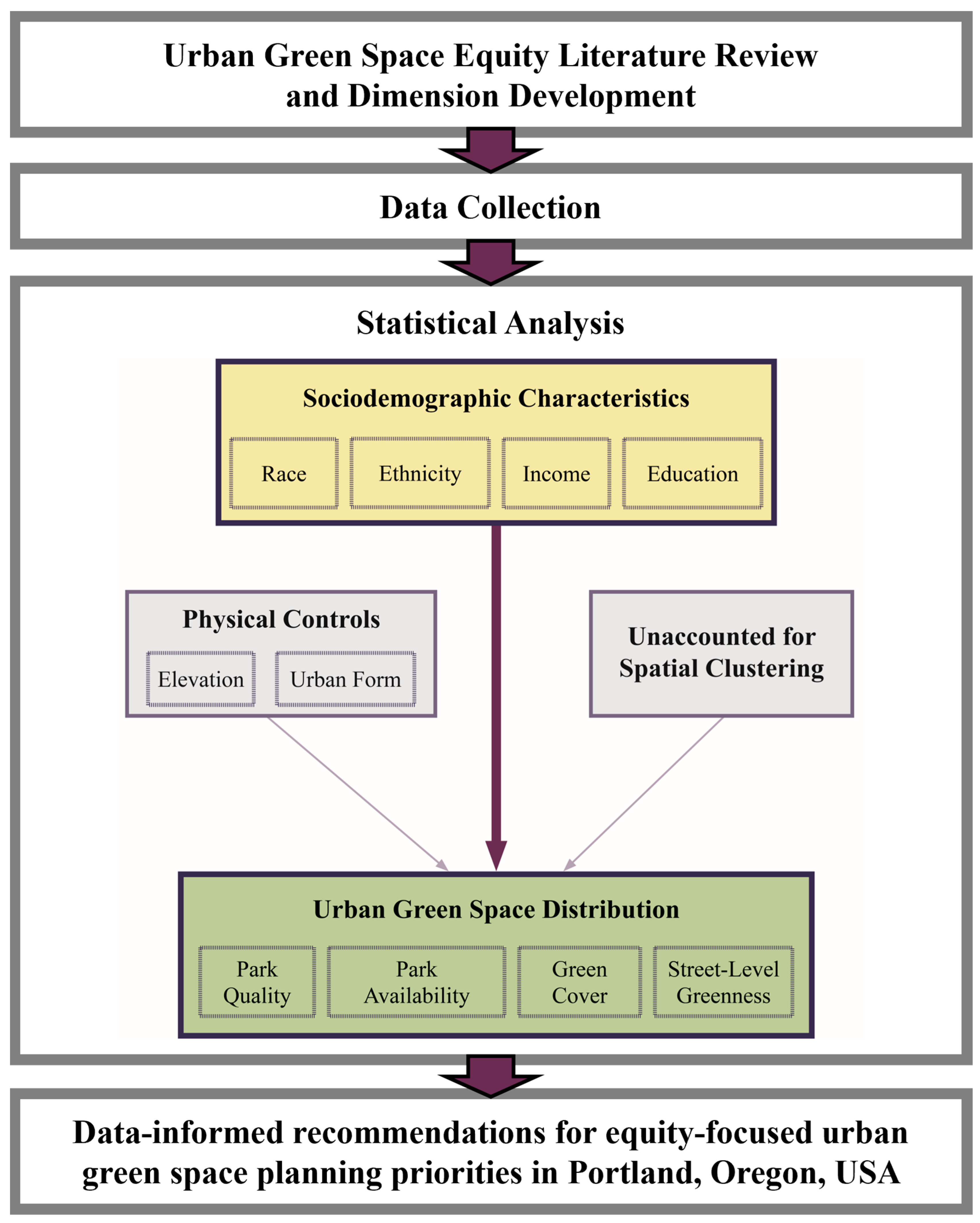
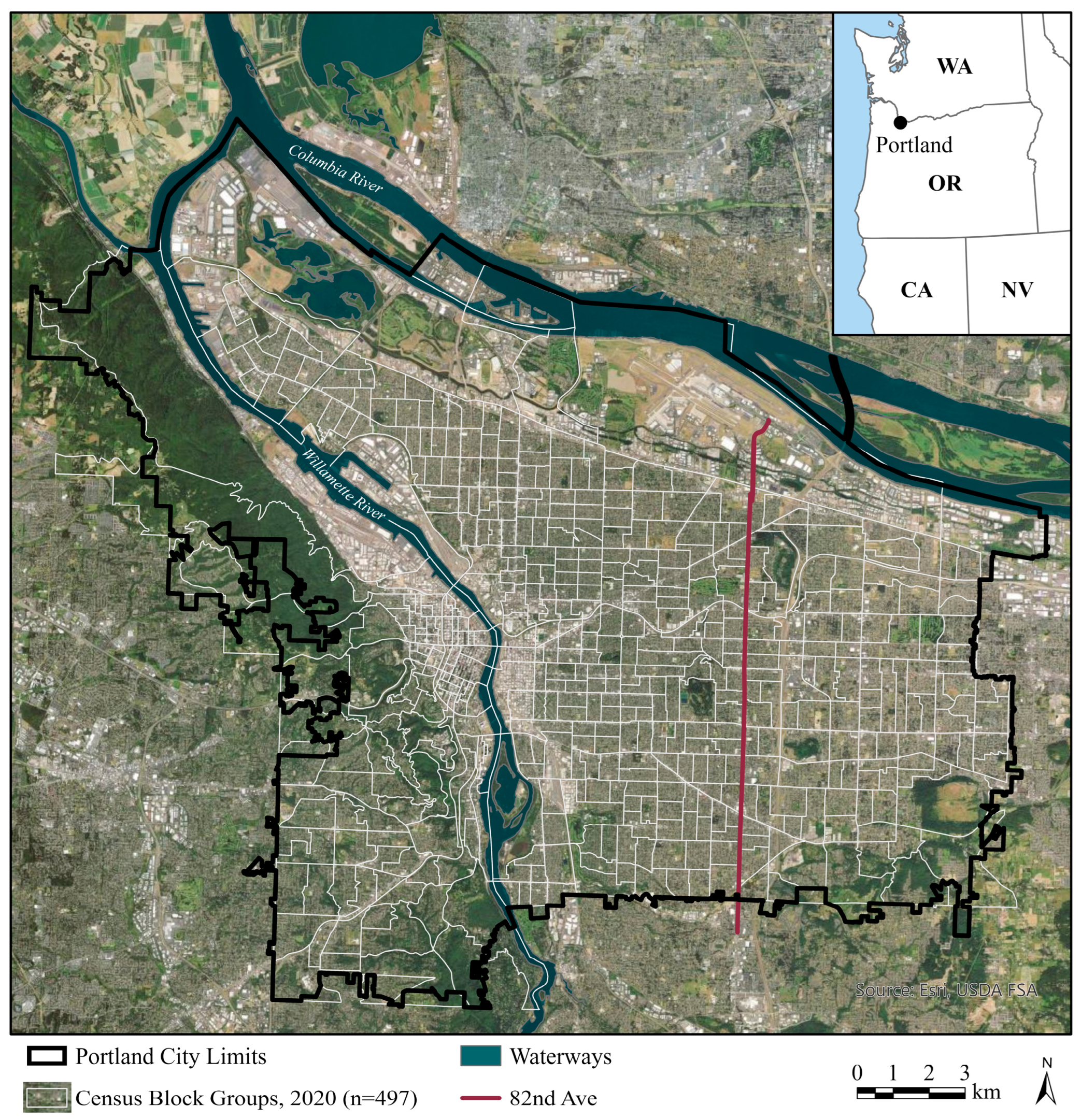

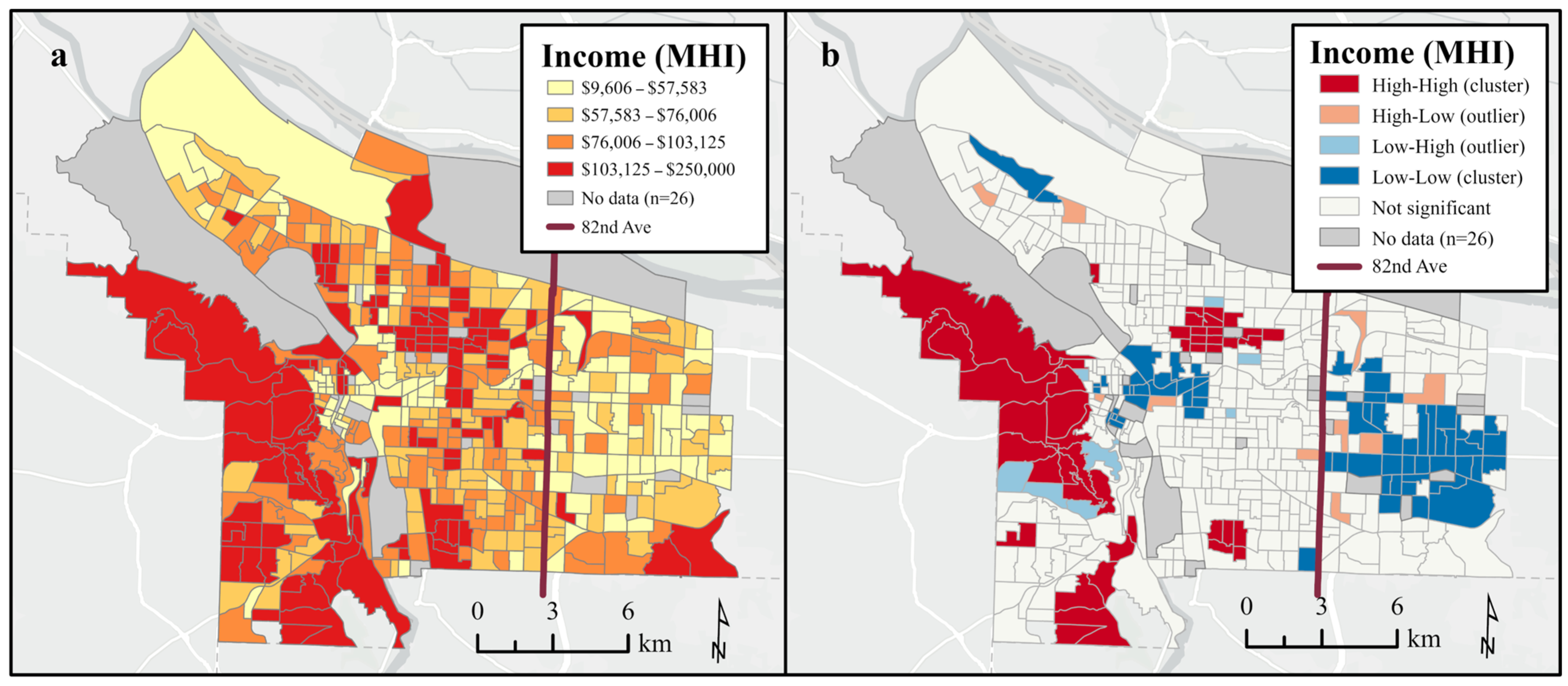
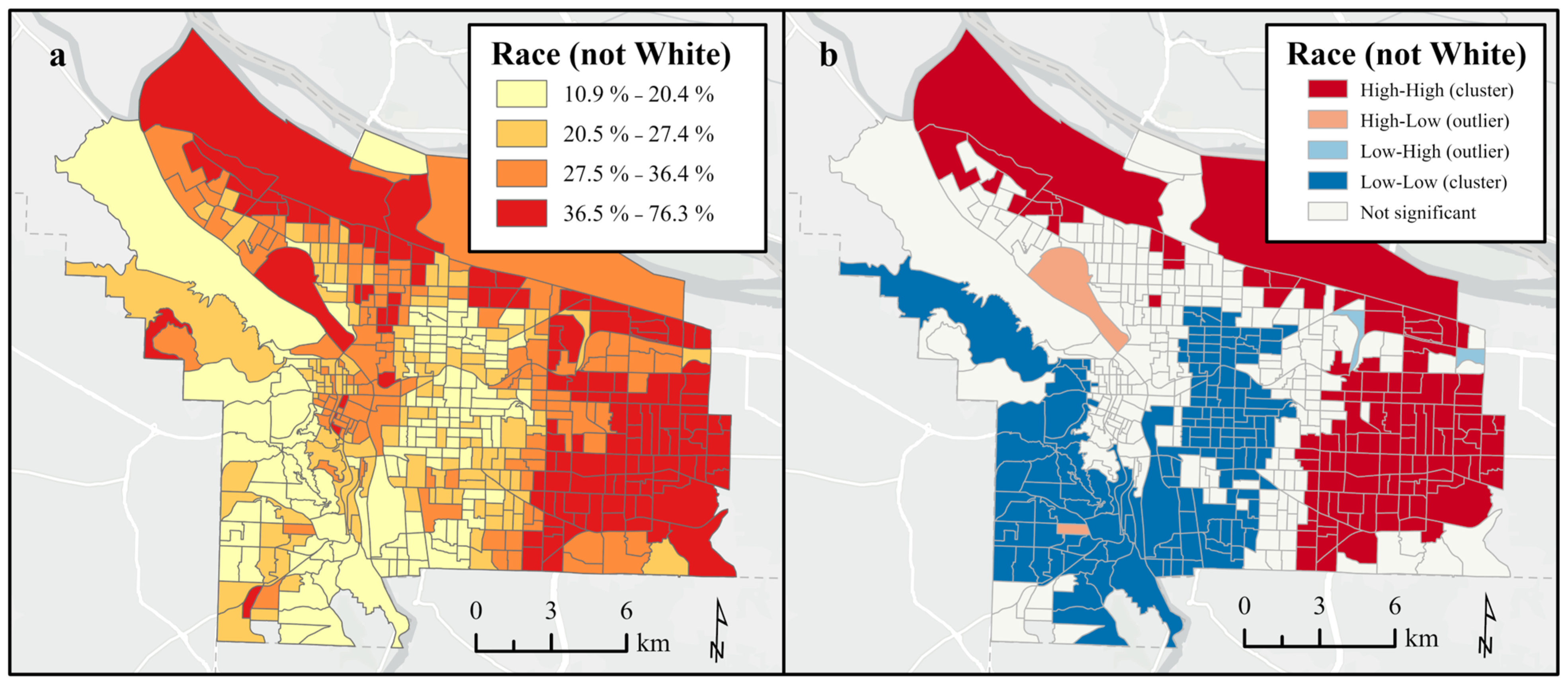
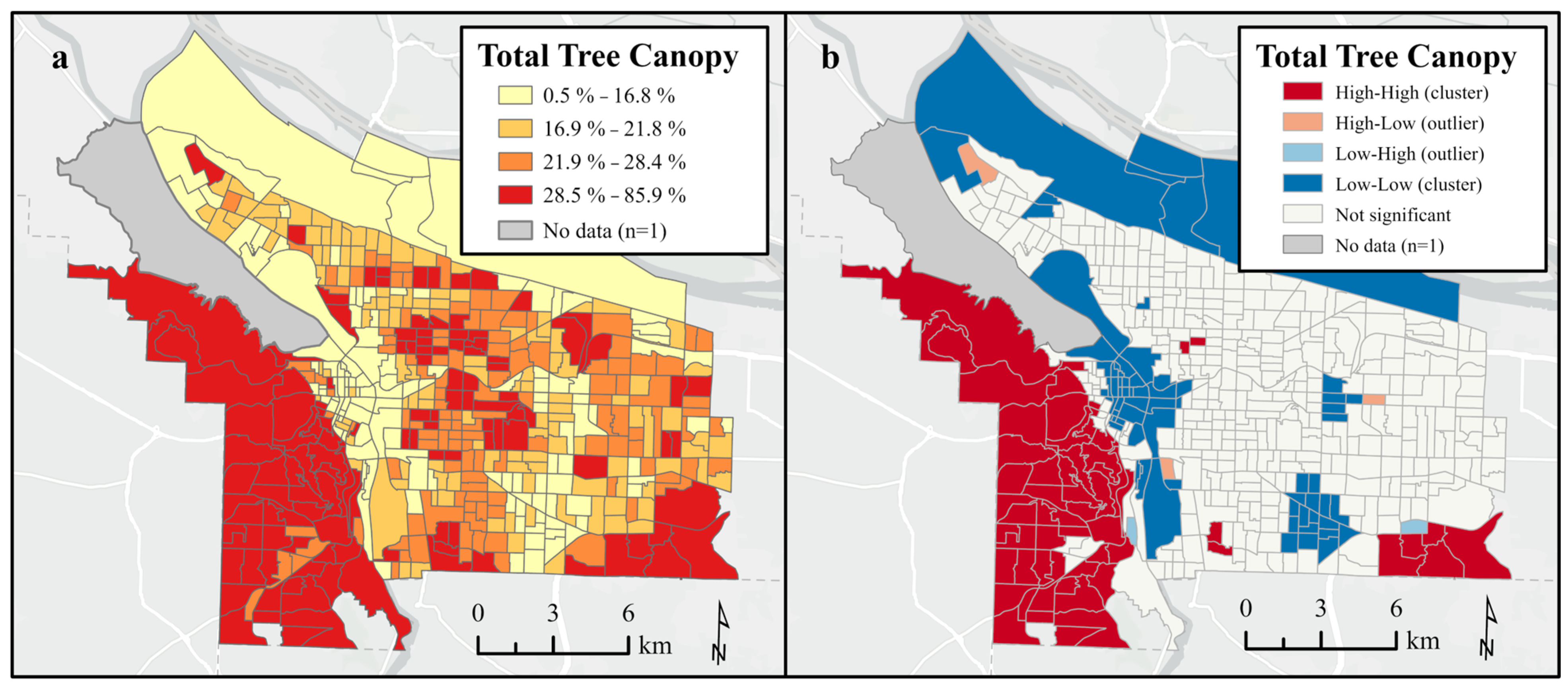
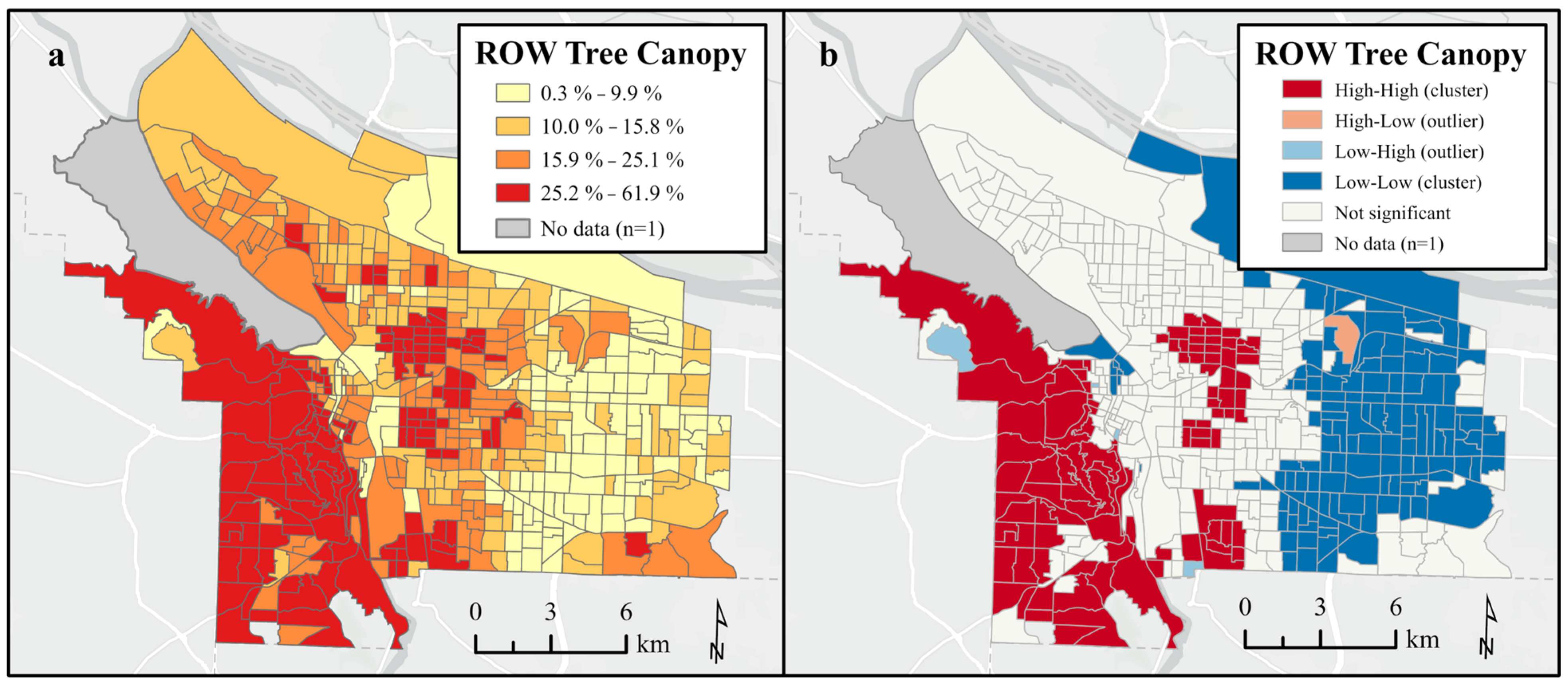
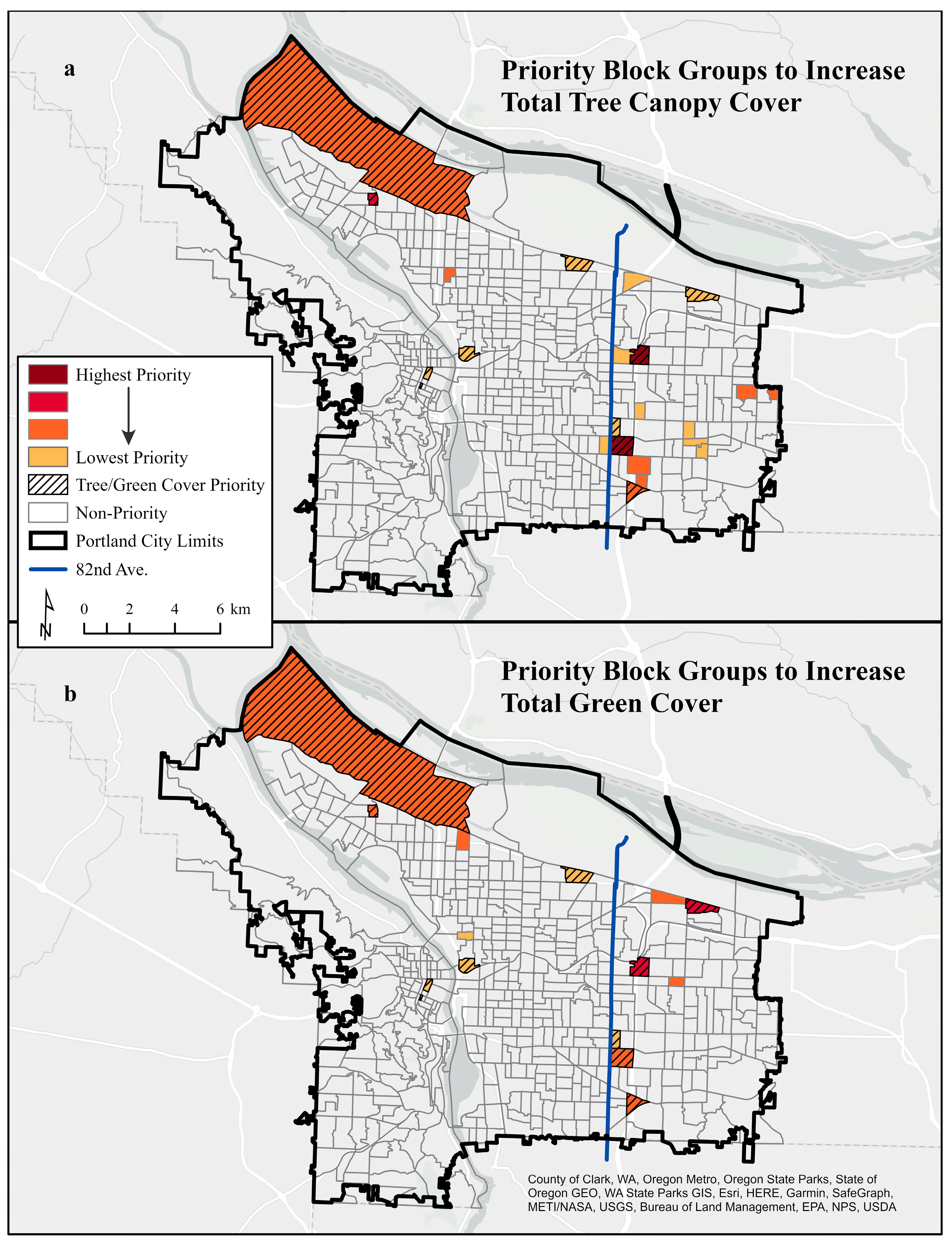
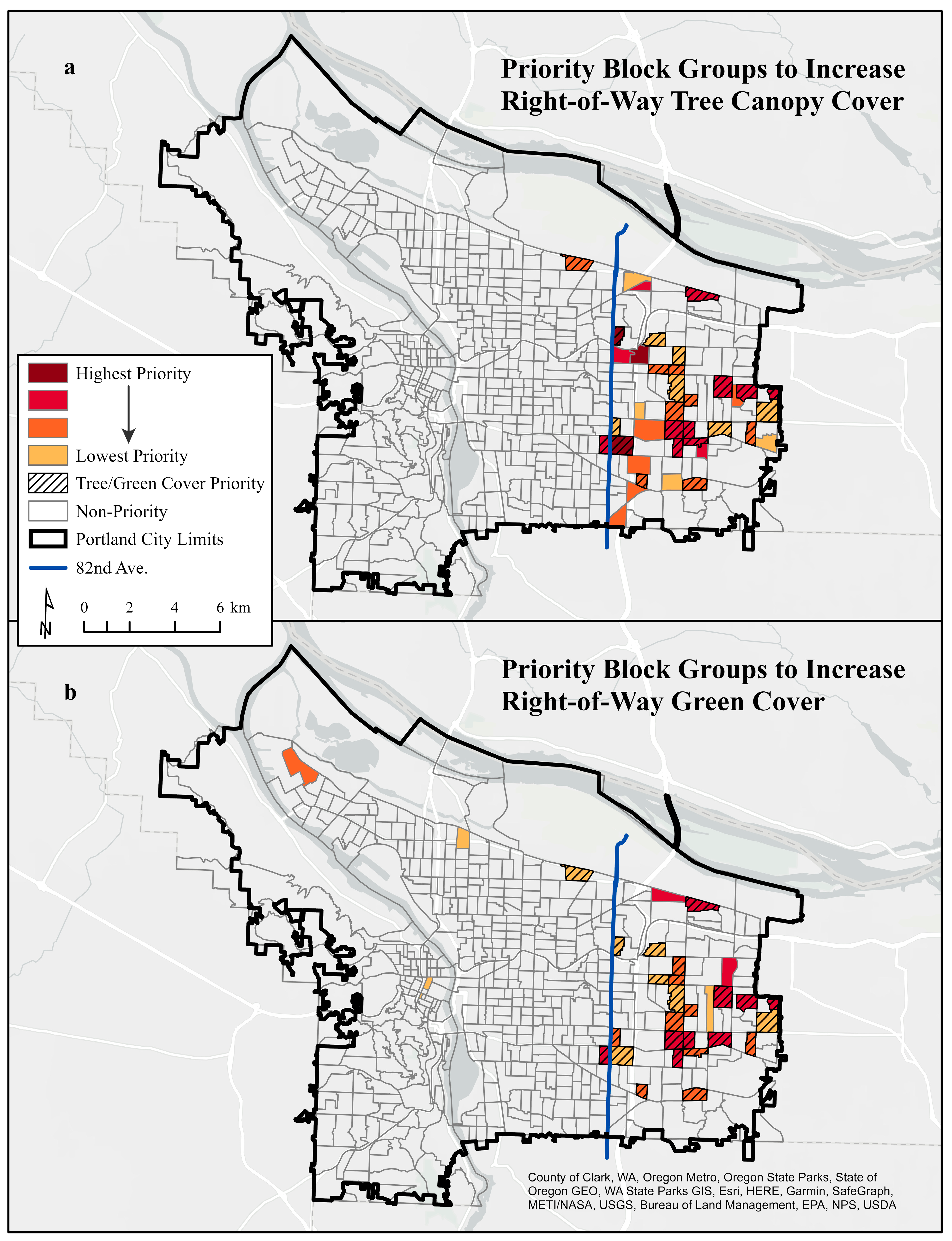


| Census Block Group Variable | Median | Range |
|---|---|---|
| Median household income a | $76,006 | $9606–$250,000 |
| Minoritized racial group b | 27.1% | 10.9–76.3% |
| Hispanic, Latinx, or Spanish origin a | 6.7% | 0.0–59.5% |
| No postsecondary education a | 37.9% | 2.0–90.4% |
| Total green cover c | 47.4% | 2.2–94.9% |
| Total tree canopy c | 22.1% | 0.5–85.9% |
| Right-of-way green cover c | 37.1% | 4.8–78.4% |
| Right-of-way tree canopy c | 16.0% | 0.3–61.9% |
| Number of parks d,e | 4 | 0–17 |
| Area of parks d,e | 13.9 ha | 0.0–2275.1 ha |
| Neighborhood Environment Scoring Tool (NEST), overall park quality score d,e | 43.6 | 0.0–84.2 |
| Green Space Variable Category * | Race (Percent Minoritized Racial Population) | Income (Median Household Income) | Education (Percent with No Postsecondary Education) | Ethnicity (Percent Hispanic/ Latinx) |
|---|---|---|---|---|
| Right-of-way tree canopy cover | −0.73 b | 0.48 b | −0.69 c | −0.34 b |
| Right-of-way green cover | −0.65 b | 0.56 b | −0.49 b | −0.33 a |
| Green View Index (GVI) | −0.71 c | 0.50 c | −0.63 c | −0.34 b |
| Overall tree canopy cover | −0.48 b | 0.43 a | −0.32 b | - |
| Overall green cover | - | 0.43 a | - | - |
| Cumulative NDVI | −0.36 b | 0.46 a | - | - |
| Private tree canopy cover | −0.31 b | 0.40 a | - | - |
| Private green cover | - | 0.36 a | - | - |
| Park tree canopy cover | −0.39 c | - | - | - |
| Park quality, overall score | - | - | −0.31 c | - |
| Park quality, non-natural aesthetics domain | - | - | −0.34 c | - |
| ROW Tree Canopy ab | ROW Green Cover b | GVI ab | Total Tree Canopy ab | Total Green Cover b | NDVI b | Private Land Tree Canopy b | Parkland Tree Canopy c | |
|---|---|---|---|---|---|---|---|---|
| Intercept | 1.35 *** | 16.09 *** | 1.51*** | 4.06 *** | 21.17 *** | 0.03 * | 17.84 *** | 3.77 * |
| Median household income ($10 k) | 0.05 *** | 0.75*** | 0.02*** | 0.04 *** | - | 3.6 × 10−3 *** | 0.31 ** | 0.16 |
| Race (percent minoritized racial population) | −0.02 *** | −0.19 *** | −7.2 × 10−3 *** | −0.02 ** | - | −2.80 × 10−4 | −0.17 *** | - |
| Ethnicity (percent Hispanic/Latinx) | - | - | - | - | −0.13 ** | - | - | −0.13 * |
| Education (percent no postsecondary) | - | - | - | - | −0.04 | - | - | - |
| Elevation (mean) | 1.30 × 10−4 | −0.01 | 1.60 × 10−5 | 0.01 *** | 0.05 *** | 3.4 × 10−4 *** | 0.15 *** | 0.03 * |
| Urban form | −0.01 | −0.66 *** | −0.02 ** | −0.09 *** | −1.54 *** | −5.7 × 10−3 *** | −1.26 *** | −0.24 |
| Pseudo-R2 | 0.66 | 0.62 | 0.63 | 0.67 | 0.7 | 0.73 | 0.77 | 0.66 |
| SAR Type (SEM or SLAG) | SLAG | SLAG | SLAG | SEM | SLAG | SLAG | SEM | SLAG |
Disclaimer/Publisher’s Note: The statements, opinions and data contained in all publications are solely those of the individual author(s) and contributor(s) and not of MDPI and/or the editor(s). MDPI and/or the editor(s) disclaim responsibility for any injury to people or property resulting from any ideas, methods, instructions or products referred to in the content. |
© 2024 by the authors. Licensee MDPI, Basel, Switzerland. This article is an open access article distributed under the terms and conditions of the Creative Commons Attribution (CC BY) license (https://creativecommons.org/licenses/by/4.0/).
Share and Cite
Elderbrock, E.; Russel, K.; Ko, Y.; Budd, E.; Gonen, L.; Enright, C. Evaluating Urban Green Space Inequity to Promote Distributional Justice in Portland, Oregon. Land 2024, 13, 720. https://doi.org/10.3390/land13060720
Elderbrock E, Russel K, Ko Y, Budd E, Gonen L, Enright C. Evaluating Urban Green Space Inequity to Promote Distributional Justice in Portland, Oregon. Land. 2024; 13(6):720. https://doi.org/10.3390/land13060720
Chicago/Turabian StyleElderbrock, Evan, Kory Russel, Yekang Ko, Elizabeth Budd, Lilah Gonen, and Chris Enright. 2024. "Evaluating Urban Green Space Inequity to Promote Distributional Justice in Portland, Oregon" Land 13, no. 6: 720. https://doi.org/10.3390/land13060720
APA StyleElderbrock, E., Russel, K., Ko, Y., Budd, E., Gonen, L., & Enright, C. (2024). Evaluating Urban Green Space Inequity to Promote Distributional Justice in Portland, Oregon. Land, 13(6), 720. https://doi.org/10.3390/land13060720





